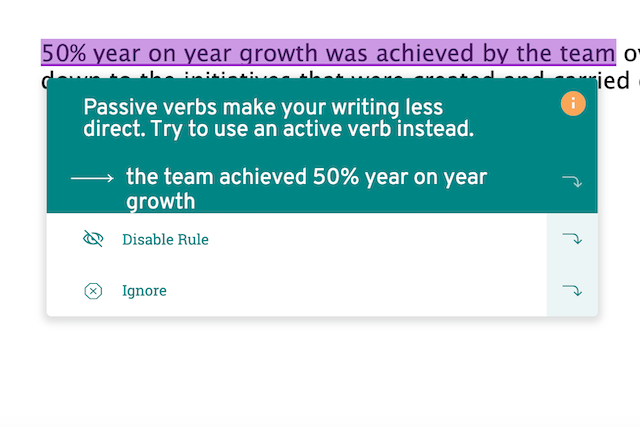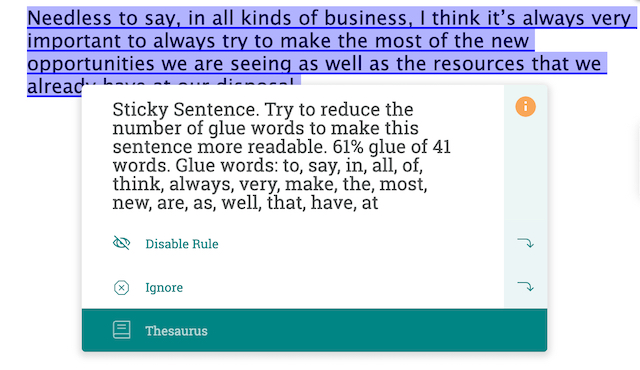
Being an entrepreneur is tough. You’re trying to grow a company, handle finances effectively, and find new clients so you don’t close up shop as others have done.
There are approximately 582 million entrepreneurs worldwide, but not all are successful.
So, what sets successful entrepreneurs apart?
Well, they are passionate, resourceful, willing to improvise, and have a strong determination to succeed.
But there’s another thing: they are also excellent writers.
They understand that good writing can help them win new business and they write directly and authoritatively—whether it’s a tweet, a blog post, an email, or a memo.
Writing is a powerful weapon when used effectively. It strengthens brands, shows professionalism, and demonstrates attention to detail.
Remember, anything you write online represents your company and brand. Poorly written content won’t sell your products, no matter how good they are. In fact, it can negatively affect sales.
Your audience’s attention span is short, as is everyone else’s, so do your best to capture it from the get-go.
So, how do you say what you want to say concisely, clearly, and accurately? Here are six tips for excellent writing.
1. Keep It Simple
According to Harvard Business Review, complex words don’t make you sound smart, they only send readers away. Successful entrepreneurs use a conversational tone when writing—which most people are drawn to.
So, use familiar words and explain complex ideas in a way that anyone can understand—even a small kid. The exception is only when you’re writing for an industry-specific audience.
Don’t write, “There were many issues that impacted the successful acquisition of new customers.” Instead, write, “These five things prevented the company from gaining new customers.”
Also, it’s important to make your content easy to skim. Here are eight ways you can do that:
- Keep paragraphs and sentences short—paragraphs should be no longer than four sentences long
- Highlight key phrases so readers know what to focus on
- Leave white space between paragraphs
- Start a sentence with but, or, or and
- Use bulleted or numbered lists
- Use visual media: images, infographics, tables, and videos
- Change up lengths—make some paragraphs long and others short
- Explain one idea in each sentence
Avoid jargon, buzzwords, and clichés in your writing. Choose words carefully and tailor your content to your audience. Always try to say more with fewer words.
This is where ProWritingAid comes in.
It helps you to steer clear of filler words and improves your spelling and grammar. Common filler words include really, so, actually, basically, and that.
2. Avoid the Passive Voice

The active voice makes your writing more direct, stronger, and purposeful. The subject is actively doing something in the sentence. Active sentences are more concrete because we know who the subject is and what they are doing.
In a passive sentence, the person performing the action isn’t always specified; there is action, but the actor may be missing. For example, you may write, "The structure was inspected yesterday and had cracks in three places." We don’t know who inspected it. It could have been the site manager, the engineer, or even the mason.
Even if you write, “The structure was inspected yesterday by the engineer and had cracks in three places," the sentence is still passive.
The passive voice is not incorrect, it is just wordy and complex. Passive sentences can be meandering and unclear.
If we rewrite this sentence in the active voice, it becomes more direct and concise: “The engineer inspected the structure yesterday and found cracks in three places."
The reader knows who discovered the cracks in an instant. Whenever the structure develops problems in the future, they can quickly refer to the material and consult the engineer.
The active voice is straightforward, clearer, and gives life to your writing. You write in a simpler way using shorter, clearer sentences that quickly get to the point.
If you want to avoid the passive voice in your writing, use the ProWritingAid Style Report. It highlights passive voice phrases and sentences that should be revised to improve readability.
3. Get Personal
Yes, get personal.
In a world where people are bombarded by content everywhere they turn, you can only stand out if you personalize your content.
Write in such a way that people feel like you’re talking directly to them. And use a conversational tone to show the reader you know exactly what you’re talking about.
The typical email open rate is 18%, but it largely depends on the subject line and the relevancy of the subject matter. There's a 50% chance that your email will be opened if it has a personalized subject line.
Personalized emails resonate better with readers because they communicate the promise of value. If you can’t convince the email recipients that your email will improve their lives or their businesses, they’ll simply delete it. Take time to personalize your subject lines and deliver relevant content to each reader.
When writing content for your brand on social networks or your blog, write the way people talk. Begin sentences with words like but, and, or, or so. When you write this way, you engage readers and their attention flows more naturally from one sentence to the next.
4. Fluff Is a No-No

Compare these two sentences:
“Mike made it a point to speak with his colleague in her cubicle at the office in order to discuss the issue of how she was constantly chatting on her phone during office hours.”
“Mike reprimanded his colleague for chatting on the phone during office hours.”
The first sentence contains unnecessary filler words and drags on for a whole paragraph. It contains very little valuable information and won't lose any value if most of the words are removed. Adding a lot of fluff to your writing only lowers its quality and may cost you a lot of readers.
Get to the point as quickly as you can. Be clear and make readers enjoy reading the content. Don’t waste their precious time. If your writing lacks focus, readers will think you also lack focus in business. Write brief paragraphs and short sentences. Stick to one idea per sentence.
You can reduce fluff in your writing with ProWritingAid’s Sticky Sentences Report. It highlights sentences containing too many vague and unnecessary words, such as really, so, often, in order to, very, a lot, that, just, absolutely, completely, and entirely.
You can also check your sentence length variety with the Sentence Length Report.
5. Use Subheadings and Bullets
There’s so much content online people simply don’t have the time to take in everything. Every single day, 4.4 million blog posts get published, 350 million photos get uploaded to Facebook, and 500 million tweets are sent.
It’s mind-boggling.
In addition, only 30% of readers prefer text-based content, so you have your work cut out if you want to keep your readers engaged.
To improve the readability of your content, use descriptive subheadings and provide the most critical information first. Subheadings help readers find and understand information quickly by capturing and holding their attention. They also keep scanners moving down the page from one subhead to the next.
Research has also shown that 79% of people scan content for key points before reading it, and that’s why you should use bullets and numbers. They present information in a simple, logical, and interesting format. They also reduce wordiness and make content easier to read by dividing it visually. But bullet points should have no more than two sentences.
It’s also important to bold and italicize crucial information. Write important information—like a deadline—in bold letters to show its importance. Bold fonts are used for strong emphasis. However, before you make content bold, consider using italics. Only use the bold tag if you aren’t satisfied by the emphasis italics add to your text.
If you blog frequently, write listicles. Readers share listicles two times more because they are short and sweet—the perfect online content. They are also easier to write than traditional articles because you don’t have to worry about the order of the points.
6. Proofread Thoroughly with ProWritingAid
Your word—written or verbal—reflects your personal brand. It makes people trust or mistrust you. Don’t damage your brand’s reputation with careless writing. Edit and proofread your content meticulously.
But you’re probably busy juggling many things, so you may not always have time to proofread everything you write. That’s why you should use an online editing tool to make your job easy—like ProWritingAid.
Well-written content enhances your credibility and makes you look professional. ProWritingAid is full of useful features, like The Echoes Report, which flags repeated words and phrases in your content, and The Readability Report, which highlights sentences that may be hard for your reader to understand.
ProWritingAid’s Grammar Report is like Microsoft Word’s spell checker with superpowers. It uses artificial intelligence algorithms to help you steer clear of embarrassing errors. ProWritingAid enhances your vocabulary, makes your writing clear and concise, and ensures your message hits the mark.
Finally, remember to read widely because leaders are readers. The average American reads 12 books a year, but most CEOs read a book a week.


